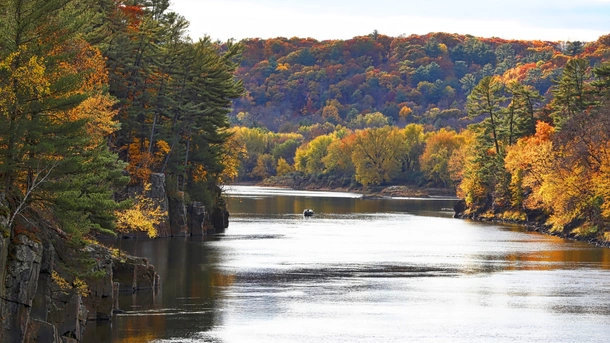Minnesota Department of Natural Resources Expresses Concern About Increasing Diversity in State Park Visitors
The Minnesota Department of Natural Resources (MDNR) has announced plans to increase diversity among visitors to their state parks. This com...

The Minnesota Department of Natural Resources (MDNR) to Increase Diversity Among State Park Visitors
The Minnesota Department of Natural Resources (MDNR) has announced plans to increase diversity among visitors to their state parks. This commitment comes after the release of the 2022 State Park Visitor Study, which revealed that only 11 percent of visitors were non-white. MDNR Parks and Trails Director Ann Pierce acknowledged the need for greater inclusivity and stated that the agency will be focusing its resources on attracting more non-white visitors.
Progress Towards Inclusivity in Minnesota State Parks
According to a visitor study, the Minnesota Department of Natural Resources (DNR) is making progress towards their goal of inclusivity. However, there is still more work to be done. The DNR aims to expand access to public lands for traditionally underserved communities and to welcome new visitors to outdoor recreation in state parks.
Increase in Non-White Visitors to State Parks
According to a study, there has been an increase in the number of non-white visitors to state parks. The study reported that the percentage of non-white visitors rose from five percent in 2017 to 11 percent in the previous year. However, it is important to note that the survey's findings may not accurately represent the overall demographic of state park visitors. This is because the study relied on voluntary participants, and the data was collected through 2,000 interviews conducted by the MDNR (Michigan Department of Natural Resources) last summer.
Study Categories and Demographics
A recent study categorized participants into two groups: white and BIPOC (Black, Indigenous, or People of Color). The BIPOC group included biracial and multiracial individuals, as well as those who identified as American Indian, Alaska Native, Asian or Asian American, Black, African American, Hispanic, Latino, Middle Eastern, North African, Native Hawaiian, or Pacific Islander.
Visitor Demographics and Desire for Inclusion
A recent study conducted in Minnesota found that visitors to state parks were predominantly white, high income, and highly educated compared to the general population. The study also revealed that these visitors expressed a desire for more Indigenous history and voices in park programming, as well as concerns about potential microaggressions and the lack of diversity during their visits.
Support for Diversity Recommendations
A recent study has supported previous recommendations by the Minnesota Department of Natural Resources (MDNR) to increase resources for diversity. The MDNR had formed the Minnesota Outdoor Recreation Task Force in April 2020, which issued final recommendations in March 2021, urging the MDNR to prioritize diversity, equity, and inclusion (DEI). The task force argued that diversity is an economic asset, as the state's BIPOC and "gender identity" populations are growing. They also claimed that racial disparities were costing the state $16 billion in GDP annually, citing a 2014 report from PolicyLink and the University of Southern California (USC) Program for Environmental and Regional Equity (PERE).
Social Media Campaign for Diversity, Equity, and Inclusion
The Minnesota Department of Natural Resources (MDNR) has launched a social media campaign promoting diversity, equity, and inclusion (DEI) on public lands and waters. This initiative comes ahead of the first anniversary of George Floyd's death. MDNR has partnered with Share the Mic MN, a racial justice activist campaign that emerged in the aftermath of Floyd's death.
Share the Mic MN Campaign
Share the Mic MN is a campaign that aims to amplify the voices of black and brown women by allowing them to take over the social media accounts of white "allies." The campaign is managed by the Edina Community Foundation and has partnered with organizations such as the U.S. Bank Foundation, Minneapolis Foundation, and Allianz.
#MyMNOutdoorAdventure Campaign and Collegiate Career Program
The Minnesota Department of Natural Resources (MDNR) is partnering with Jasmine from Share the Mic MN for the #MyMNOutdoorAdventure campaign. They are encouraging people to share their stories of diversity in outdoor activities. The MDNR is also involved in a collegiate career program called Increasing Diversity in Environmental Careers, which is specifically for individuals who identify as women, BIPOC, and/or disabled. The program is managed in collaboration with the Conservation Corps Minnesota and Iowa, Minnesota Pollution Control Agency, and Minnesota Board of Water and Soil Resources.
Increase in Non-White Visitors to Minnesota State Parks
According to an interview with Gratia Joice, the principal planner for MDNR Parks and Trails, there has been an increase in non-white visitors to Minnesota state parks. Joice stated that this increase in diversity among park visitors is encouraging and that the survey shows a rise from 5% in 2017 to 11% in 2022.
Working Towards Demographic Balance
The Minnesota Department of Natural Resources (MDNR) is working towards achieving a balance between the population demographics of Minnesota and the demographics of visitors to state parks. According to the Census Bureau, Minnesota's population consists of approximately 77.6% white individuals (not Hispanic or Latino), 7.6% black or African American, 1.4% American Indian and Alaska Native, 5.5% Asian, 0.1% Native Hawaiian or other Pacific Islander, 2.8% biracial or multiracial, and 6% Hispanic or Latino.
Goal for Racial Parity
According to the MDNR's classification of BIPOC (Black, Indigenous, and People of Color), the benchmark for achieving racial parity is set at or above 23.4 percent. Although there has been some improvement, there is still more work to be done, according to Joice.
